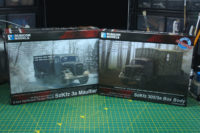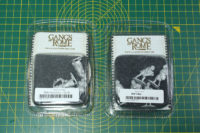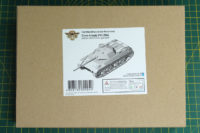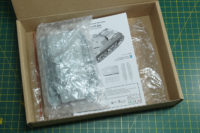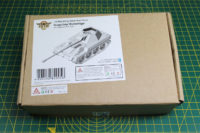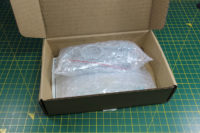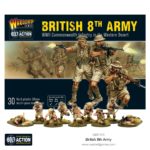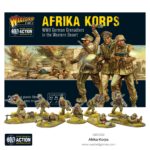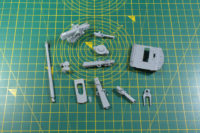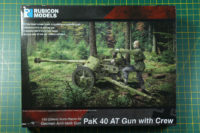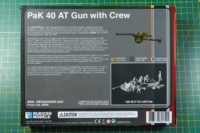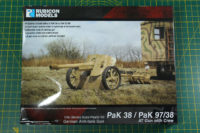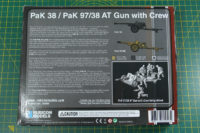Rubicon Models SdKfz 301a Opel Maultier with Box Body
Based upon the already available Opel Blitz Kit (RM280026), Rubicon published the Maultier variant that replaces the rear wheels with tracks. As with some of their other kits, like the SdKfz 25x, they cover further accessories. For the Blitz and Maultier there is the option to upgrade the cargo bed with the box body "Einheitskoffer".
After the first winter in 1941 on the Eastern Front, the German army high command realised that the trucks weren't capable of handling the weather and terrain conditions. The vehicles often got stuck in the mud and snow. A unit of the Waffen-SS build the tracks of a Bren Carrier under a truck to confront those conditions. After realising the benefits of this modification in 1942, Opel, Ford and Daimler added these variants to their truck production. Depending on by whom the LKW Gleiskette 2t was build, it was called SdKfz 3a (in case it was built by Opel), 3b (Ford V3000 S) or 3c (Daimler L4500). The variant was called Maultier (mule) and further variants were build upon the halftrack vehicles, like the Panzerwerfer or with a 2-cm Flak 38.
Das Boot – inspiring wargaming
I watched the tv mini-series version of the original movie Das Boot from 1981 on amazon prime last year or the year before. It had enhanced audio and video quality, with 6 episodes covering 52 minutes each. In November and December 2018 a tv series sequel of the same name, was released as an 8-part. It plays 9 month after the original movie, and due to the nearly 40 years between both movies, of course with different actors. I had the chance to see the location and mock-up of the submarine in Munich, in the Bavaria Filmstudio. It was quite impressive to see and transported the claustrophobic atmosphere of the submarine quite well.
Heer46 Carro Armato P43 Bis
Following the Krupp-Steyr Waffenträger from Tuesday, today we unpack and build the Armato P43 Bis by Heer46.
This is another tank from the resin series produced in cooperation with Rubicon Models. The Armato P43 was an Italian heavy tank that was developed by FIAT and Ansaldo, but never left the draft stage. The sources why the development stopped are not clear, some say the design was dropped in favour of the lighter P26/40 tank, but it is likely that the resources were just not available after the armistice of Italy with the Allies in 1943 and the Axis had other things valued higher than Italian tank development. Only two mock ups were build, but as mentioned before not further progressed. The tank was intended to weigh around 30 tons and have a 420-430 hp diesel V12 engine. The name Carro Armato P43 stands for armoured vehicle, P for pesante - Italian for heavy - and the number '43 most likely standing for the development year.
Heer46 Krupp-Steyr Waffenträger
There is a new range of 1:56 scale resin kits produced by Heer46 in cooperation with Rubicon Models, as an addition to Rubicon extensive plastic range. One of the vehicles offered as part of this assortment is the Krupp-Steyr Waffenträger.
Among the several Waffenträger (and their blueprint / papertank / prototypes) the Krupp Steyr Waffenträger is one of the less known vehicles. And like many of his kind, this tank destroyer never actually saw service. Only a similar concept of this Waffenträger, known as the Ardelt project was produced and can be seen nowadays in the Kubinka tank museum in Russia. Two wooden models and one trial Waffenträger were produced in 1944, that had a chassis constructed by Steyr mainly using parts from the RSO (Raupenschlepper Ost), and armed with an 8,8 cm KwK 43. This was the base for the model we see here. Due to the turret, and in combination with a small mobile ramp, the firing arch of this Waffenträger was amazing versatile. As this is a rather special vehicle, there aren't that many further information available. Most may know the Waffenträger from games likes Warthunder or World of Tanks.
Bolt Action British 8th Army Commonwealth Infantry
As already mentioned with the review of the Afrika Korps box, the Western Desert supplement is supported by two new infantry kits, and here is the second one, the British 8th Army Commonwealth infantry kit.
As these were prepared at the same time, we had the chance to see the 3-Ups at this year's Salute in April 2018. The Africa campaign is something special to many wargamers, especially those with relatives, who fought in that battle. The duel between Montgomery and Rommel is often connected with some kind of chivalry, a mutual respect between both opponents. Surely glorified to some degree, as war is war, but still a somewhat special part of World War 2 and therefore of special interest for many people.
Similar to the Afrika Korps box, who was released 1973 (!) by Airfix, the 8th army plastic kit was even around earlier than this, in the 1960s, so for some of the veterans in our rows, these were among the first toy soldiers they to play battles on the living room floors or kitchen tables. Thus reminding many wargamers to their first memories of this hobby.
Bolt Action Deutsches Afrika Korps German Grenadiers
Warlord Games released for Bolt Action the latest campaign supplement, The Western Desert, and this time the book is accompanied by not just one but two new plastic kits. We're talking about the Afrika Korps Grenadiers we're going to review today and the 8th Army Commonwealth Infantry we'll see here as well.
We were shown the 3-Ups of these kits at our visit to the Warlord Games Studio and the day after at the Salute 2018 in London back in April. The wargaming crowd is eager to get their hands on both of these boxes. But why is that so? Well, back in the day, when the now veterans of our hobby started, long before there was this broad range of miniatures made from plastic, pewter or resin, the only commonly available resource for toy soldiers were 1:72 or 1:32/1:35 plastic kits from companies like Airfix (if you're British) or Revell (if you're German). And from what I've heard, for many people the conflict in North Africa was in particular interesting from the war stories that they heard from their parents or grandparents.
Heer46 8,8 cm Pak 43
Heer46, the German resin forge for small series, released this 8,8 cm PaK 43 late 2017 / early 2018 and it fits well, with this week's anti-tank gun theme. I have covered their Panther F-Schmalturm and Sd.Kfz. 247 Ausf. B on here as well.
Initially designed by Krupp as a competition to the 8,8cm FlaK 41 (the second generation of the 8,8 cm Flak 18/36/37), it was reworked and went into production in 1942. The first units were mounted to the Nashorn tank destroyers, later in mid 1943 available on cross outrigger or split rail carriages (as PaK 43/41).
Rubicon Models PaK 40 AT Gun with Crew
After a brief detour into the Wild West, we're back to anti-tank gun week with the PaK 40 by Rubicon Models.
The 7,5 cm Panzerabwehrkanone 40 or PaK 40 was the backbone of the late war German anti-tank guns. More than 23.000 units were produced and mostly used on carriages, but some were mounted to tank destroyers like the Marder series. Development of the PaK 40 started early, when the first Soviet tanks were brought to Berlin in 1939 and the 5 cm ammunition of the PaK 38 that was still tested at that point, proofed to be not powerful enough to deal with the newer designs of slopped and thicker armour.
Rubicon Models PaK 38 – PaK 97/38 AT Gun with Crew
Today we're looking at the successor of the PaK 36, the PaK 38 by Rubicon Models. This kit covers the variants 38 and 97/38 of the anti-tank gun including a crew.
Rheinmetall-Borsig, who produced the earlier PaK 36 as well, were ordered to develop a new, heavier anti-tank gun after the Spanish Civil War. After an initial sketch of a new pattern named 37, which was not approved by the German authorities, they had to come up with an improved version, the PaK 38. This more powerful anti-tank gun was one of the few guns being able to penetrate the sloped armour of the T-34 in 1941.
